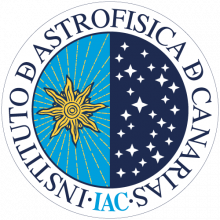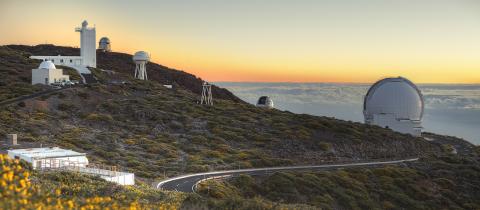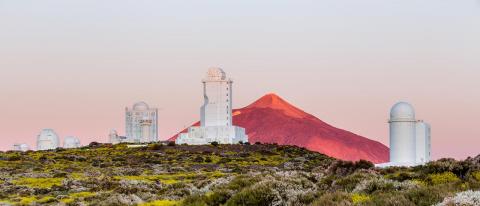


General information
-
Hosting OrganisationOBSERVATORIOS DE CANARIAS
-
AddressObservatorio del Roque de los Muchachos: Pico del Roque de los Muchachos, Garafía (La Palma, Spain)
-
Contact Info:
-
Phone
-
Emailcontacto@iac.es
Description
The Instituto de Astrofísica de Canarias (IAC) administers this Singular Scientific and Technical Infrastructure (ICTS), formed by the Observatorio del Roque de los Muchachos (ORM) in La Palma island, and the Observatorio del Teide (OT) in Tenerife island. The excellent astronomical quality of the sky at the Canary Islands -thoroughly characterized and protected by law- makes these observatories astronomical reserves, open to the international scientific community since 1979. Currently the OCAN host telescopes and instruments belonging to more than 75 institutions from 25 countries, being the most important set of astrophysical infrastructures within the territory of the European Union for visible and infrared nocturnal and solar research, and the largest collection of multinational telescopes worldwide. Other experiments for high-energy astrophysics and the study of the cosmic microwave background complete the infrastructures available.
Main equipment or Facilities
ORM offers one of the most complete telescope arrays around the world. There are a number of night-time observation telescopes: GTC, WHT, TNG, NOT, INT, LT, Mercator and JKT. It also has one solar telescope: SST and other infrastructures like the Cherenkov telescopes, MAGIC I and II, SuperWASP, two DIMMA, SHABAR, CILBO and the ESFRI Research Infrastructure CTA-North.
OT is ideally suited for studying the sun, concentrating on of the best European solar telescopes in operation: GREGOR and THEMIS. In addition, it also has a number of night-time observation telescopes: TCS, Stella I and II, OGS, ATLAS, SONG, IAC80, MONS, SLOOH I and II, BRT, EarthShine, TST, TTTs, MASTER, LCOGT CILBO, EAST and TIZON. Most of them are remote or robotically operated. The OT also has a Solar Physics Laboratory with some instruments; two telescopes –QUIJOTE I and II-, TMS GROUNDBIRD and STRIP, to study the Cosmic Microwave Background Radiation, the ASTRI mini array for High Energy Physics and several experiments to check the sky quality: DIMMA, SHABAR, SQM-LE, AstMon.
Projects under Development
The IAC conducts projects on the operation and viability of telescopes (EST, FDI, OGS, OPTICON), infrared (EMIR, MIRADAS, FRIDA, HARMONI, HIRES), and visible (HORUS, ESPRESSO, GREGOR, WEAVE, DESI) instrumentation, adaptive optics (GTCAO and LGS, EDiFiSE, FastCam, AOLI) or microwave (QUIJOTE). Major research infrastructures projects include CTANorth, EST and NRT among others
Technology Capabilities
The IAC develops much of the technology used for its research programmes in-house. The Technology Division is responsible for designing, developing and building the instruments needed for astrophysical observation. The IAC Instrumentation Area provides technology, development and production support for research and technological development projects. This area has staff who are highly qualified in the disciplines of mechanics, optics, electronics and software and have access to advanced development and production techniques. The Division is organized into Engineering and Production and structured as a matrix, with project managers coordinating the resources.
The expertise of the division includes the following areas: Optical system design and testing, Mechanical and opto-mechanical system design and development, Cryogenic and vacuum system design and development, Precision mechanics, Adaptive optics, Fibre optics, Control systems, Sensor characterisation, Project management, Systems engineering, Electronic systems, Software design and Laser communications.
Requests from individuals or public or private entities outside the IAC which relate to require human or material resources administered by the IAC Instrumentation Area are managed by the OTRI office.
Summary of Research Services
Under the terms of the Agreement on Cooperation in Astrophysics, Spain provides the site in return for a percentage of the available observing time at each of the telescopes or instruments. Observing time is awarded through the Time Allocation Commission (CAT), comprising a Solar Committee and a Night Time Committee.
There are different schemes to apply for observing time: ordinary calls (twice a year); Spain-Mexico GTC collaborative time; IAC-Nordic collaborative time; Director Discretionary Time; International Time Programme. Every semester, a number of nights of CAT time are available to service observations of short scientific programmes. The Sevice Time observations are carried out by the IAC’s Support Astronomers Group and the presence of the user astronomer in the telescope is not required. The service time is available for six telescopes: WHT,INT,NOT and TNG at ORM, under CAT time, and TCS and IAC80 Telescopes at the OT, under non-CAT time.
Pure research activities at the IAC are organized into six subject areas covering most fields within Astrophysics whether theoretical, observational or instrumental. The IAC conducts projects on earth and space telescopes, high resolution, infrared instrumentation, optics and microwaves, as well as technological support.
Procurement process
Law 9/2017, of 8 November 2017, on Public Procurement, which transposes Directives 2014/23/ EU and 2014/24/EU of the European Parliament and of the Council, of 26 February 2014, into Spanish law